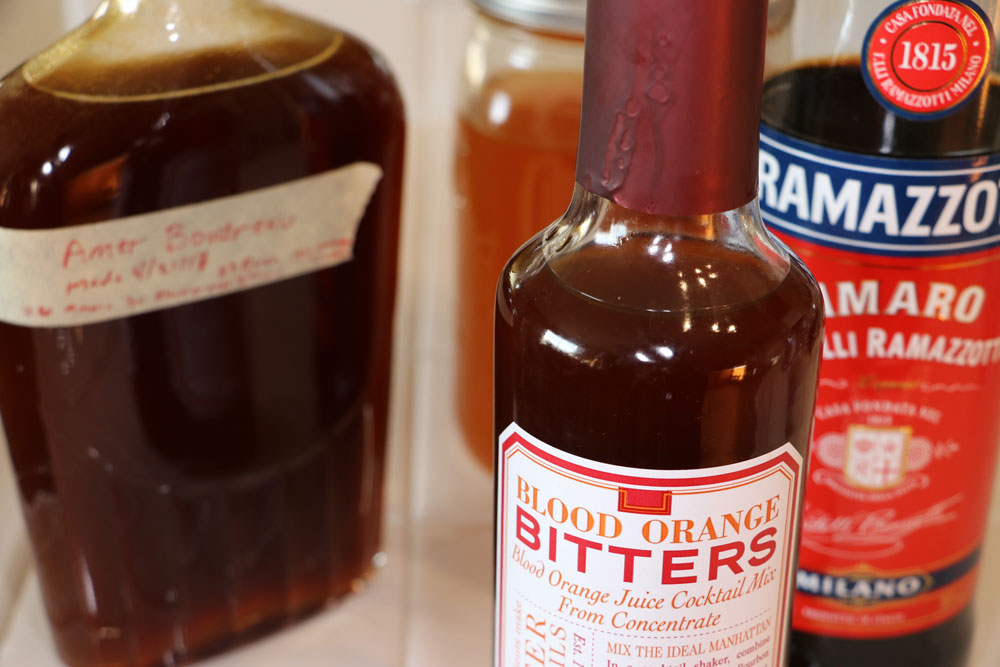Amer Picon will go down in the history of this Mr. Boston’s experiment as the only ingredient we could not get a hold of. Perhaps one day this French aperitif will once again grace our fair shores but for now we’d need a ticket to Europe to get the real thing.
Thankfully we aren’t the only ones who have been searching high and low for Amer Picon’s bitter orange goodness. Down the rabbit hole of research I found a recipe for one man’s quest to perfect an Amer Picon clone. Dubbed Amer Boudreau, Jamie Bourdreau is said to have created a version that is purported to be “essentially identical to the original” by seasoned mixologists at Tales of the Cocktail. Having no personal knowledge with which to develop my own version, and not as lucky as Jaime to pee my pants while jumping at the glee of finding a bottle, the Amer Bourdreau recipe looked like it would do the trick.
Not knowing what to expect and not in need of several bottles of Amer, we opted for a slimmed down version of the recipe. My math brain, Ryan, calculated the recipe down by a factor of 9 which left us with roughly 500 ML of finished spirit.
We had no idea what to expect of the finished product though I had feared based on other descriptions I’d read that it would taste like Campri which isn’t my favorite liqueur of all time due to its extreme bitterness. To my delight, our Amer Picon substitute is very tasty. The addition of the fresh orange tincture we’d steeped for just over a month smoothed out the bitterness of the Stirrings and Amaro. It is a very nice drink indeed although you’d never know it by its looks.
I have to say that Amer Boudreau isn’t the most attractive color I’ve ever seen. The Amaro Ramazzotti is a very dark burnt sienna to start and when mixed with the dark ruby blood orange and vibrate orange tincture the result is a hazy brown slightly lighter and warmer than a Root Beer. But looks aside, this is a very unique mixer and if you have a cocktail that is darker in color such the Amer should not detract.
One strange chemical reaction we found was that despite the ingredients being sans carbonation, the combination started to fizz and formed a light layer of bubbles on the top of the bottle. Maybe after we follow Jaimie’s instructions to let the ingredients meld in the fridge for a week or so that will change.
In our excitement and due to a want to keep our blog series on track, Ryan and I decided to go ahead with the mixing of Mr. Boston’s next recipe without letting our new Amer Picon substitute rest the required week. We’ll give it another go next week and see if anything changes 🙂
The aptly named Amer Picon Cocktail was the next drink on the list. It’s hard to believe we’ve only gotten to page 5! A combination of equal parts Amer Picon, and Grenadine, the addition of 1/2 ounce Gin and ice melt did not come close to filling the noted 4 ounce cocktail glass. Since Mr. Cotton did not specify whether 1/4 meant ounce or 1/4 of a glass, I decided to alter the recipe to improve the presentation of the finished drink.
Using 1 ounce of our Bathtub Gin No.6 and 1/2 ounce each of the Amer and Grenadine; I shook the mixture vigorously for about 20 seconds to try and get additional ice melt to help fill the glass. My efforts appear to have paid off and the 4 ounce cocktail glass was filled roughly 3/4 of the way rather than the puny 1/3 of a glass the original attempt yielded.
Unlike the Allies Cocktail, our Gin worked nicely with the Amer Picon Cocktail. I think the added botanical notes added something to the 33 herbs purported to be found in the Amaro Ramazzotti. All and all, this was a really delightful cocktail and both of us enjoyed it very much. If I were to change anything, I might try and add a bit more ice melt to tone down the thickness of the Grenadine and Amer. It is a rich drink but not too rich. I just think that a little more delusion would be more refreshing.
In case you are curious about the flavor of Amaro Ramazzotti verses a more widely used Campari, I did a side by side comparison of the two and here’s my two cents…
The Negroni classic ingredient Campari is very bitter on it’s own. From the company website, Campari’s flavor is “obtained from the infusion of bitter herbs, aromatic plants and fruit in alcohol and water.” If I had to guess I’d say that the 157 year old recipe uses grapefruit juice and peel along side Gentian Root and possibly Grand Wormwood. While both Amaro Ramazzotti and Campari hail from Milan, Italy; the two could not be more different.
Campari is a light rose-orange and Amaro Ramazzotti a dark burnt sienna. While Campari smells fruity, the later spirit is similar to Root Beer with an orange zest. Amaro Ramazzotti is also bitter but in a more pleasant way to my taste buds. I’d liken it to eating the pith of an orange peel rather than the very potent bite of say macerated Artemisia absinthium.
I personally much prefer the Amaro Ramazzotti over Campari though both serve needs in their respective cocktails. The two are so different it probably isn’t fair to even try and compare them.
Hopefully someday Ryan and I will get the opportunity to try an authentic bottle of Amer Picon first hand. Maybe a trip to Europe is in order 😉 Until next time, à votre santé!

